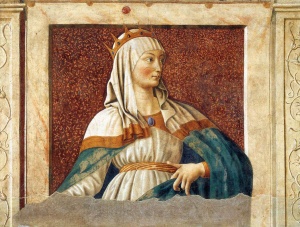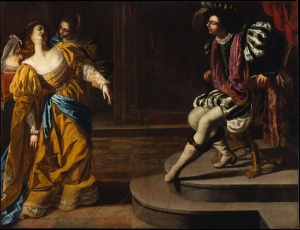In Search of Images of Esther
I was thinking about Esther the other day when I realized that there are almost no Jewish representations of our most favorite heroine and her story. Now of course the tradition of illuminated megillas, many produced in the 17th century, is an exception. Unfortunately those works pale next to the innumerable depictions of Torah narratives and scenes of Jewish life found in so many illuminated and printed Haggadahs. In Bezalel Narkiss’ authoritative study, Hebrew Illuminated Manuscripts (Keter Publishing, 1969) there are 60 examples of Hebrew illuminations from bibles, codices, children’s books, ketubot, haggadot, Rambams, siddurs, mahzorim, and scientific books. Not one Megillah Esther!
So I set out on a quest for any images of Esther I could find. Then I remembered the decorated walls of the Dura-Europos synagogue done in 250 C.E. Located in the provincial Roman town of Dura-Europos along the Euphrates River, the synagogue walls were originally covered with no less than 50 panels of figurative Torah narratives. And flanking the Torah niche on the western wall is a depiction of the Triumph of Mordechai, celebrating Jews and the enthroned King Ahasuerus and Queen Esther. We don’t see Esther in ancient synagogue mosaic floors, extant synagogue decorations or even nineteenth century Jewish painting, but here she is in the first flowering of Jewish art, proclaiming a message of hope and faith.

In search of images of Esther we have to wait over a thousand years for the next Esther to appear in 1450. She was depicted by the early Renaissance master Andrea del Castagno as one of the illustrious ancient and contemporary Renaissance men and women in a fresco from the Villa Carducci near Florence. Appropriately dressed in a white headdress of purity trimmed with the gold of royalty she is crowned, an ideal beauty, calm, intelligent and assured.
The next set of Esther images I came across established the dominant motif for the next 400 years. The artworks show Esther approaching the King, violating the ban on anyone approaching the King unless summoned. In painting after painting it is the salient episode in the narrative that the artist and patron have determined is of crucial importance. Esther is shown approaching or bowing before the seated King, accompanied by her maidens, simultaneously exhibiting courage and fear as she is determined to save her people. In some depictions she bows and the King extends his royal scepter to permit and acknowledge her presence. More frequently she is seen swooning into the arms of her female assistants, eliciting compassion in the King who rushes to her aid. While this episode is not found in our Hebrew text, a version is seen in the Midrash Rabba and in the Catholic version of the story that contains an addition called the Greek Esther.

The Venetian master Tintoretto depicts Esther (1548) having sunk to her knees, unconscious and incapable of righting herself. Three maids struggle with their limp mistress while the King has risen and rushes to help his Queen.
The motif of the swooning Esther dominates the late Renaissance and Baroque images possibly because of its inherent drama and emphasis on the power of a woman in distress to open the heart and mind of the hapless Ahasuerus. One artist who subtly exploited this motif was Artemisia Gentileschi. Her Esther Before Ahasuerus (1623) found in the Metropolitan Museum of Art was reviewed here in February 2001. Suffice it to say that her Esther swoons in a totally calculated manner, her eyes momentarily closed for effect, more theater than emotional crisis, and thoroughly designed to manipulate the foppish King before her. It is Esther at her most powerful.

Surveying some 25 images of Esther three important exceptions to the “swoon rule” appear. First on the Sistine ceiling Michelangelo condenses the narrative in a totally idiosyncratic manner; first showing Ahasuerus in bed directing Haman to honor Mordechai, then opposite a vignette of Esther condemning Haman before a startled King. Finally in the center is the punishment of Haman, crucified on a barren tree.
Rembrandt also confounds the norm with his famous but puzzling etching,Triumph of Mordechai (1641). The uneasy calm of both Mordechai and Haman is broken by the twisting head of the horse, here representing the King, and the shock and uproar of the surrounding crowd. Likewise his depiction of Haman Condemned by King Ahasuerus (1655) in the Budapest National Gallery seems oddly sympathetic to the evil Haman.
The most intriguing exception is seen in a series of three large ceiling paintings (1556) by Paolo Veronese, the Renaissance master, in the church of San Sebastiano in Venice. This was Veronese’s local church and he spent close to 15 years decorating it with 16 major paintings. Of them, the three in the magnificent nave, 35’ high, are unique in that they depict the only non-Christian subject in the church, the story of Esther. It is fairly clear that these works played a major role in establishing his reputation and success as a master artist.
![Banishment of Vashti (1556), (Detail), oil on canvas by Paolo Veronese Courtesy Church of San Sebastiano, Venice [wga.hu] Banishment of Vashti (1556), (Detail), oil on canvas by Paolo Veronese Courtesy Church of San Sebastiano, Venice [wga.hu]](https://richardmcbee.com/wp-content/uploads/2008/03/Veronese_Vashti_detail-239x300.jpg)
![Esther Crowned by Ahasuerus (1556), (Detail), oil on canvas by Paolo Veronese Courtesy Church of San Sebastiano, Venice [wga.hu] Esther Crowned by Ahasuerus (1556), (Detail), oil on canvas by Paolo Veronese Courtesy Church of San Sebastiano, Venice [wga.hu]](https://richardmcbee.com/wp-content/uploads/2008/03/Veronese_Esther_crowned_detail-300x249.jpg)
Veronese’s intentions are unknown but for us these three episodes are especially thought provoking. In Vashti’s banishment we see her descending the palace stairs looking back in wounded puzzlement. A massive figure on the right grasps her forfeited crown as she is hustled away, the only legitimate royalty barred from the King’s presence. While we might empathize with her plight (in spite of her cruelty that the midrash reports) we know only too well that without Vashti removed there is no chance for the eventual salvation of the Jews through the newfound queen Esther. Vashti and her downfall are pivotal.
So too is Esther’s coronation. Everything about Veronese’s image is calculated to beguile us, draw us into the moment of her ascent to power. She is seen from below, calmly looking up at the king as he places the crown on her head, modestly her hands are placed on her chest. As the reflected light illuminates her beautiful face, she kneels on bended knee and we can well imagine the consternation of a pious Jewish girl forced into a royal harem and then chosen as queen to a pagan monarch. One of the two maidens who observe the moment is doing something almost unheard of in Renaissance narrative paintings; she is staring directly out at the viewer. All we can see is her face, her hair and forehead beautifully adorned in pearls, a virtual echo of the sumptuous Venetian beauty Veronese depicted as Esther. She seems to tell us to pay particular notice to this event, and we know the future of the Jewish people depends upon it, especially since off to the right we see the figure of Haman looming, ominously clad in shinny black armor.
While the Triumph of Mordechai initially brings no new insight into the narrative as the first two images, it does brilliantly demonstrate Veronese’s masterful technique of foreshortening and illusionistic perspective to give the effect of seeing these scenes from below, which then echoes the experience of looking up at the ceiling to view the artwork. The black and white horses stomp with nervous anticipation as their riders, the crowned but somber Mordechai and the bare-headed Haman are led by servants. Both Mordechai and Haman look off in different directions, equally unaware of the imminent consequences of this dramatic parade. We know the one in power will be dead soon, and Mordechai the Jew will soon rescue his people. Veronese seems to have willfully tampered with the literal text to bring home this message.
But what a ceiling: Vashti looks innocent but must be removed, Esther is truly innocent but is thrust into the dangerous complexities of the royal court, and finally two powerful men vie for power with unseen consequences for both.
Veronese’s Esther paintings stand outside of the normative depictions of the Esther story and skillfully draw us into a complex political drama. Which is exactly the genius of Megillah Esther that defines the holiday of Purim; a time of mystery and danger that summons our courage and faith to do the right thing for the safety and future of the Jewish people. It was true then and no less true now in our time.